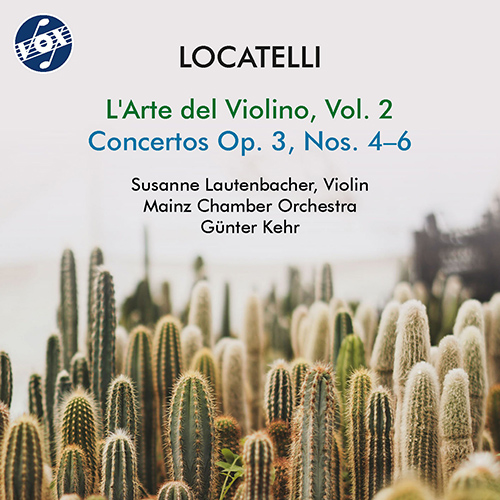Exclusively available for streaming and download.
LOCATELLI, P.A.: Arte del violino (L'), Vol. 2 - Violin Concertos, Op. 3, Nos. 4-6 (Lautenbacher, Mainz Chamber Orchestra, Kehr)
Tracklist
Mainz Chamber Orchestra (Orchestra)
Kehr, Gunter (Conductor)
Mainz Chamber Orchestra (Orchestra)
Kehr, Gunter (Conductor)
Mainz Chamber Orchestra (Orchestra)
Kehr, Gunter (Conductor)
Mainz Chamber Orchestra (Orchestra)
Kehr, Gunter (Conductor)
Mainz Chamber Orchestra (Orchestra)
Kehr, Gunter (Conductor)
Mainz Chamber Orchestra (Orchestra)
Kehr, Gunter (Conductor)
Mainz Chamber Orchestra (Orchestra)
Kehr, Gunter (Conductor)
Mainz Chamber Orchestra (Orchestra)
Kehr, Gunter (Conductor)
Mainz Chamber Orchestra (Orchestra)
Kehr, Gunter (Conductor)
Mainz Chamber Orchestra (Orchestra)
Kehr, Gunter (Conductor)
Mainz Chamber Orchestra (Orchestra)
Kehr, Gunter (Conductor)
Mainz Chamber Orchestra (Orchestra)
Kehr, Gunter (Conductor)
Susanne Lautenbacher studied violin with Karl Freund in Munich, then privately with Henryk Szeryng, and became strongly associated with the first-fruits of the post-World War II early music movement. This reputation hardly prepares one for the outstanding tonal expression, delivery and pacing of Lautenbacher’s twentieth-century repertoire. Weill’s Violin Concerto (1991) is well-enunciated and driven, the biting irony of Weill’s textures being conveyed in a spare, dry sound. The Hartmann performance here is equally effective in its quasi-Stravinskian Neo-Classical overtones.
In her 1972 Brahms Concerto Lautenbacher appears to follow Joachim’s edition and we hear influences from Szeryng and the Joachim–Auer line. Some nineteenth-century subtleties—particularly, vocal differentiation between passagework and melody—are lost, however.
Her 1962 recording of Biber’s Mystery Sonatas is well known amongst aficionados of so-called authentic performance. In fact Lautenbacher uses a modern violin setup and, as with Melkus, the historicism scarcely goes deeper than simply playing relatively arcane repertoire with supporting period instruments. Taking Sonata No. 2 as an example we hear a clean, direct, if rather gritty sound, with vibrato present but reined-in. The vibrato is not unusual in this phase of period performance—Robert Donington’s article in the New Grove Dictionary of Music and Musicians (1980) reveals that even scholars assumed some form of vibrato to be a permeating characteristic of eighteenth-century style. The recording would not qualify today as in substantially historically-informed, but at the time the incorporation of early instruments and such traits as upper-note trills counted as Baroque style, as did the implacable retention of stable tempi.
Locatelli’s Concerto No. 1 from L’arte del violino (1957) is comparable. Here the orchestral style is more or less modern, apart from some little swells on longer notes and the presence, of course, of a harpsichord. The cadenza is well-articulated and there are some very neat up-bow staccatos in the finale; otherwise, Lautenbacher’s vibrato, her rather metallic tone, and periodic forays into a quasi-Heifetz sound (going high on lower strings and executing modern portamenti) all reflect the usual practices of her time, toned down to respect the antiquity of the repertoire, rather than a true historical approach. She tackles this music courageously, only failing on occasion to pull off Locatelli’s challenging high-register writing. Such issues also affect Lautenbacher’s otherwise creditable Quattro stagione from 1966.
Although Lautenbacher’s recordings of early repertoire from the 1950s and 1960s are vital historic documents, it is the modern works that are most convincing.
© Naxos Rights International Ltd. — David Milsom (A–Z of String Players, Naxos 8.558081-84)

The Italian composer and violinist Pietro Antonio Locatelli was born in Bergamo, later moving to Rome, where he might have studied with Corelli but more probably was a pupil of Valentini. He won a reputation as a virtuoso, performing in Italy, Bavaria and Berlin. In 1729 he settled in Amsterdam, where he taught and conducted an amateur orchestra and was able to pursue his wider cultural interests.
Orchestral Music
Locatelli wrote a number of concerti grossi, following the example of Corelli. The first set, published in Amsterdam in 1720, includes 12 fugues. L’arte del violino (‘The Art of the Violin’), published in 1733, contains 12 violin concertos and 24 caprices, precursors of Paganini’s famous set for unaccompanied violin. A set of six concertos was published two years later and another set of six, published in 1744, is scored for four violins, two violas and basso continuo. Locatelli combines the Roman style of Corelli with, in his solo concertos, the virtuosity of Vivaldi in Venice.
Chamber Music
Locatelli also published sets of trio sonatas and solo sonatas, including a set of the latter for flute and basso continuo.































